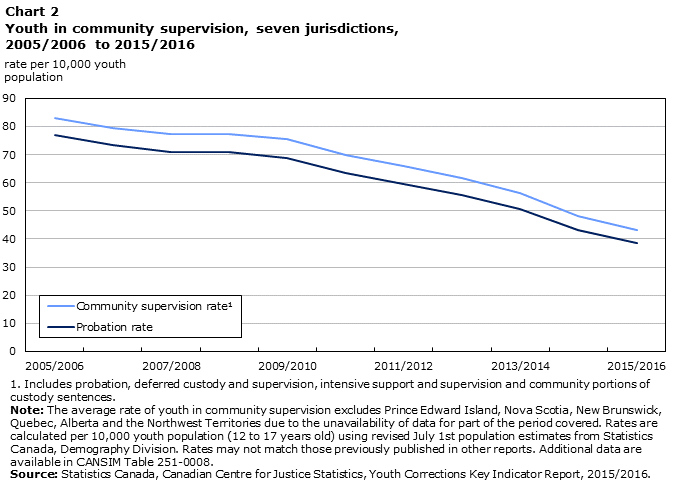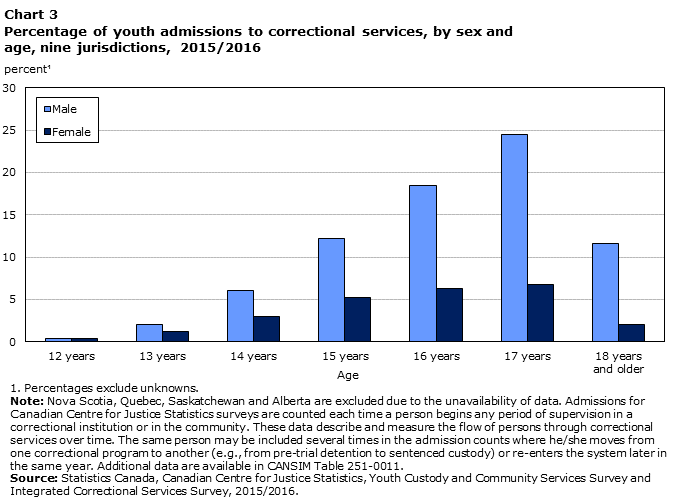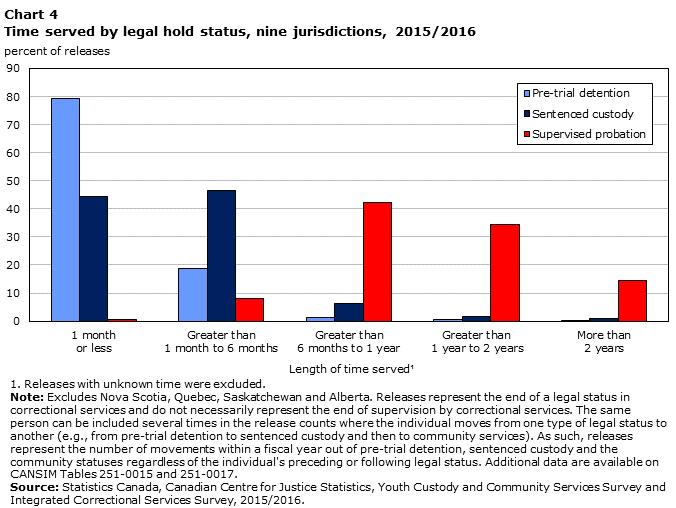Youth correctional statistics in Canada, 2015/2016
Archived Content
Information identified as archived is provided for reference, research or recordkeeping purposes. It is not subject to the Government of Canada Web Standards and has not been altered or updated since it was archived. Please "contact us" to request a format other than those available.
by Jamil Malakieh
The Youth Criminal Justice Act (YCJA), enacted in 2003, is the legislation that governs how youth aged 12 to 17 years are to be dealt with by the Canadian justice system. The Act provides for a separate youth justice system based on the principle of diminished moral blameworthiness or culpability of youth. The youth justice system is meant to protect the public by holding young people accountable in a manner that is proportionate to the seriousness of the offence and the degree of responsibility of the young person. The Act also promotes appropriate rehabilitation and reintegration of youth into the community by offering various community sanctions. Within this legislative framework, set by the federal government, the provinces and territories are responsible for administering youth correctional services in Canada.Note 1Note 2
This Juristat article presents an overview of youth correctional services in Canada for 2015/2016. The utilization of correctional services is described in this article using three measures: average counts, initial entry and admissions. Average counts provide a snapshot of the correctional population and represent the number of youth in custody or under community supervision on any given day. Initial entry represents the number of youth entering the youth corrections system for a period of supervision. Admissions count each time youth begin or move to a new type of custody or community supervision. The same person can be included several times in the admissions counts whenever the individual moves from one type of legal status to another providing an indication of the flow of youth through the system (see Text box 1).
Data on average counts come from the Youth Corrections Key Indicator Report, while data on initial entry and admissions come from the Youth Custody and Community Services Survey and the Integrated Correctional Services Survey. It should be noted that not all jurisdictions were able to report data for 2015/2016. Exclusions are noted where applicable (see Text box 1).
Rate of youth in correctional services decreases
- In 2015/2016, on any given day, there were a total of 8,455 youth aged 12 to 17 years who were supervised in either custody or a community program in the ten reporting jurisdictions.Note 3 This was equivalent to a rate of 49 youth in correctional services for every 10,000 youth in Canada. The rate of youth in correctional services was down 11% when compared to 2014/2015 and down 33% compared to five years earlier (Table 1). This trend is in line with the decline in youth crime reported by police and the number of completed cases in youth courts. The number of youth charged by police decreased 25% between 2011 and 2015.Note 4 Youth courts completed 29% fewer cases between 2011/2012 and 2014/2015.Note 5
- On an average day in 2015/2016, 89% of the youth correctional population were under community supervision.Note 6
- The majority of reporting jurisdictions showed decreases in the daily rate of youth under correctional supervision between 2014/2015 and 2015/2016. However, Yukon (+54%) and Nunavut (+4%) were exceptions. Of the jurisdictions that reported a decrease in rates from the previous year, Prince Edward Island’s was the largest at -26% (Table 2).
Youth incarceration rate continues to decline
- In 2015/2016, there was an average of 998 youth being held in some type of custody on any given day in the 12 reporting jurisdictions. This represents a youth incarceration rate of 5 per 10,000 youth, down 3% from the previous year and 27% from 2011/2012 (Table 1).Note 7
- British Columbia had the lowest incarceration rate at 2 per 10,000 youth, while Yukon had the highest rate at 29 per 10,000 youth among the reporting provinces and territories in 2015/2016 (Table 2). In comparison with courts data, Yukon, for the third consecutive year, had the highest proportion of youth court guilty cases that resulted in a custody sentenced in 2014/2015 (48%). British Columbia, at 18% of guilty cases with a custody sentence, was closer to the national average of 15% (Miladinovic 2016).
- Since 2007/2008, youth held in pre-trial detention have outnumbered those held in sentenced custody (Chart 1). In 2015/2016, the rate of youth in pre-trial detention was 3 per 10,000 youth, while that for sentenced custody was slightly less at 2 per 10,000 youth.Note 8
Rate of youth supervised in the community continues decade long downward trend
- In 2015/2016, there were on average, 7,514 youth per day being supervised in the community.Note 9 The rate of youth in community services among reporting jurisdictions fell 12% from the previous year (Table 1).Note 10 The rate of youth under community supervision has been trending downwards for more than 10 years (Chart 2).Note 11 In the last five years, between 2011/2012 and 2015/2016, the community supervision rate has decreased a total of 34% (Table 1).
- On a typical day in 2015/2016, of the youth being supervised in the community, nearly 9 in 10 youth were on probation (Table 1).Note 12
- British Columbia reported the lowest daily rate of youth in community supervision in 2015/2016 at 19 per 10,000 youth, while Manitoba at 139 per 10,000 youth had the highest rate (Table 2).
The majority of youth enter correctional services under community supervision
- Initial entry measures the number of youth commencing an uninterrupted period of correctional supervision and provides an indication of new workload entering the corrections system. In 2015/2016, 5,077 youth began a period of supervision in correctional services in the eight reporting jurisdictions.Note 13 This was down 8% from the previous year and decreased 49% when compared to 2011/2012 (Table 3).
- For those entering the system in 2015/2016, about two-thirds (68%) of youth began their period of supervision in the community with nearly half (46%) beginning their period of supervision in probation (Table 3).
- In 2012, the YCJA was amended in order to simplify decision-making regarding pre-trial detention and ensure that youth be managed in the community where possible. In 2015/2016, 1,562 youth (31%) started their period of correctional supervision in pre-trial detention. The number of youth entering pre-trial detention was down 7% from the year before and down 47% when compared to 2011/2012.Note 14
Admissions to correctional services decline
- In 2015/2016, the total number of youth admissions to correctional services among the nine reporting jurisdictions fell 7% to 16,545 admissions when compared to 2014/2015.Note 15 Admissions to community supervision fell by 9% and admissions to custody fell 4% (Table 4).
- The majority of reporting jurisdictions reported decreases in total admissions to correctional services in 2015/2016. Yukon (+80%) and Newfoundland and Labrador (+6%) were exceptions (Table 4).
- Except for Yukon (+78%), all reporting jurisdictions experienced decreases in admissions to community supervision when compared to 2014/2015. Despite the overall decrease in custody admissions, six of the nine reporting jurisdictions reported increases. Yukon had the largest increase in custody admissions at 81%, whereas British Columbia had the smallest increase at 1% (Table 4).
Older male youth account for the majority of admissions to correctional services
- In 2015/2016, three-quarters of youth admitted into correctional services were male.Note 16 Female youth accounted for a slightly higher proportion of custody admissions (27%) as compared to community admissions (23%) unchanged from 2011/2012 (Table 5).
- The majority (56%) of youth admissions to correctional services in 2015/2016 involved youth aged 16 and 17 at the time of admission.Note 17 This was particularly true for custody admissions where 16- and 17-year-olds accounted for 60% of admissions, while the proportion for community admissions was lower at 52%. Youth aged 12 and 13 years accounted for 4% of admissions to correctional services (Table 5).
- In 2015/2016, males aged 17 accounted for the largest proportion of overall admissions, at 24% whereas males aged 17 account for 9% of the general youth population. Next were 16-year-old male youth, at 18% of admissions who also account for 9% of the youth populationNote 18 (Chart 3).
Aboriginal youth continue to be over-represented in the correctional system
- There were 5,642 Aboriginal youth admitted to correctional services in 2015/2016, representing 35% of admissions (Table 5).Note 19 The number of admissions of Aboriginal youth increased (6%) from 2014/2015 when Aboriginal youth represented 33% of admissions. Aboriginal youth aged 12 to 17 account for about 7% of the youth population in the nine reporting jurisdictions.Note 20
- The sentencing principles in the YCJA mandate youth courts to consider alternatives to custody, with particular attention to the circumstances of Aboriginal youth.Note 21 In 2015/2016, 54% of Aboriginal youth admitted to correctional services were admitted to custody whereas the comparable figure for non-Aboriginal youth was 44%. The proportion of Aboriginal youth admissions to custody has grown over time. In 2014/2015, 52% of Aboriginal youth admitted to correctional services were admitted to custody, while in 2011/2012, the comparable figure was 48%.
- In 2015/2016, Aboriginal female youth accounted for 43% of all female youth admitted to correctional services. This figure was higher in comparison to male youth, where Aboriginal males accounted for 31% of all male youth admitted. These findings were virtually unchanged from the previous year. However, this was an increase when compared to 2011/2012 when Aboriginal female youth represented 38% of female admissions and Aboriginal male youth accounted for 26% of male youth admitted to correctional services.
Length of time youth serve varies by type of custody
- In 2015/2016, the majority of youth (79%) released from pre-trial detention were there for one month or less whereas 53% were there for one week or less. These figures are down slightly from 5 years earlier when the proportions 82% for one month or less and 57% for one week or less (Chart 4).
- For youth released from sentenced custody in 2015/2016, (45%) were there for one month or less, with 91% spending six months or less (Chart 4). These figures were virtually the same as those for 2011/2012.
- One-half (51%) of youth released from probation in 2015/2016 were supervised for 1 year or less, unchanged from 2014/2015 (Chart 4).
- Females tend to be under correctional supervision for shorter periods of time. In 2015/2016, 86% of female youth were released from pre-trial detention after one month or less compared to 76% of male youth. Similarly, for sentenced custody, 61% of females were released after one month or less, whereas for males the figure was 40%.

Data table for Chart 1
| 2005/2006 | 2006/2007 | 2007/2008 | 2008/2009 | 2009/2010 | 2010/2011 | 2011/2012 | 2012/2013 | 2013/2014 | 2014/2015 | 2015/2016 | |
|---|---|---|---|---|---|---|---|---|---|---|---|
| rate per 10,000 youth population | |||||||||||
| Incarceration rateData table Note 1 | 9 | 9 | 9 | 9 | 8 | 8 | 8 | 7 | 6 | 6 | 5 |
| Sentenced rate | 5 | 5 | 4 | 4 | 4 | 4 | 4 | 3 | 3 | 3 | 2 |
| Pre-trial detention rateData table Note 2 | 4 | 4 | 5 | 5 | 4 | 4 | 4 | 4 | 3 | 3 | 3 |
Source: Statistics Canada, Canadian Centre for Justice Statistics, Youth Corrections Key Indicator Report, 2015/2016. |
|||||||||||

Data table for Chart 2
| 2005/2006 | 2006/2007 | 2007/2008 | 2008/2009 | 2009/2010 | 2010/2011 | 2011/2012 | 2012/2013 | 2013/2014 | 2014/2015 | 2015/2016 | |
|---|---|---|---|---|---|---|---|---|---|---|---|
| rate per 10,000 youth population | |||||||||||
| Community supervision rateData table Note 1 | 83 | 79 | 77 | 77 | 76 | 70 | 66 | 62 | 56 | 48 | 43 |
| Probation rate | 77 | 74 | 71 | 71 | 69 | 63 | 60 | 56 | 51 | 43 | 39 |
Source: Statistics Canada, Canadian Centre for Justice Statistics, Youth Corrections Key Indicator Report, 2015/2016. |
|||||||||||

Data table for Chart 3
| 12 years | 13 years | 14 years | 15 years | 16 years | 17 years | 18 years and older | |
|---|---|---|---|---|---|---|---|
| percentData table Note 1 | |||||||
| Male | 0 | 2 | 6 | 12 | 18 | 24 | 12 |
| Female | 0 | 1 | 3 | 5 | 6 | 7 | 2 |
Source: Statistics Canada, Canadian Centre for Justice Statistics, Youth Custody and Community Services Survey and Integrated Correctional Services Survey, 2015/2016. |
|||||||

Data table for Chart 4
| Length of time servedData table Note 1 | |||||
|---|---|---|---|---|---|
| 1 month or less | Greater than 1 month to 6 months | Greater than 6 months to 1 year | Greater than 1 year to 2 years | More than 2 years | |
| percent of releases | |||||
| Pre-trial detention | 79 | 19 | 1 | 1 | 0 |
| Sentenced custody | 45 | 47 | 6 | 2 | 1 |
| Supervised probation | 1 | 8 | 42 | 34 | 15 |
Source: Statistics Canada, Canadian Centre for Justice Statistics, Youth Custody and Community Services Survey and Integrated Correctional Services Survey, 2015/2016. |
|||||
Detailed data tables
Table 1 Average counts of youth in correctional services, selected jurisdictions, 2015/2016
Table 2 Average counts of youth in correctional services, by jurisdiction, 2015/2016
Table 4 Admissions of youth to correctional services, by jurisdiction, 2015/2016
Start of text box
Text box 1
Youth corrections surveys concepts and coverage
Average counts provide a snapshot of the youth corrections population and represent the number of youth in custody or under community supervision on any given day. Usually, corrections officials perform daily counts of youth in their facilities and monthly counts of youth under community supervision. These are used to calculate the annual average daily custody and community counts used in this report.
Initial entry represents the first point at which a youth commences an uninterrupted period of supervision within the youth corrections system. Each person is counted only once during their period of involvement with correctional services, regardless of subsequent changes in legal status.
Admissions for Canadian Centre for Justice Statistics surveys are counted each time a person begins any period of supervision in a correctional institution or in the community. These data describe and measure the flow of persons through correctional services over time. The same person may be included several times in the admission counts where he/she moves from one correctional program to another (e.g., from pre-trial detention to sentenced custody) or re-enters the system later in the same year. Admissions therefore represent the number of entries of persons during a fiscal year to pre-trial detention, sentenced custody or a community supervision program, regardless of the previous legal status.
The youth incarceration rate represents the average number of youth in secure or open custody per day for every 10,000 individuals in the youth population (12 to 17 years old). It includes youth in sentenced custody, youth in Provincial Director Remand being held following the breach of a community supervision condition, youth in pre-trial detention awaiting trial or sentencing, and youth in other temporary detention.
Not all provinces and territories reported complete data for 2015/2016. Jurisdictions excluded from particular analyses due to non-reporting are noted throughout the article, and include the following:
- Average counts data for Quebec (custody supervision, community supervision and total correctional services).
- Average counts data for Nova Scotia and New Brunswick (community supervision and total correctional services).
- Average counts data for Alberta for 2014/2015 (community supervision and total correctional services).
- Admissions data for Nova Scotia, Quebec, Saskatchewan and Alberta.
- Initial entry data for Prince Edward Island, Nova Scotia, Quebec, Manitoba and Saskatchewan.
These data are administrative data. Even though surveys try to standardize the way the data are reported, limitations due to differences in jurisdictional operations can restrict uniform application of the definitions in some situations. Therefore, caution is required when making comparisons between jurisdictions.
It should be noted that some of the jurisdictional counts presented in this analysis, particularly those for youth in custody, are small, small changes in the count can therefore result in large year-to-year percentage changes.
End of text box
Survey description
The Youth Corrections Key Indicator Report provides data that are used to calculate average counts of youth under correctional supervision. Usually, correctional officials perform daily counts of inmates in their facilities and monthly counts of offenders under community supervision. The following exclusions are noted for historical data: Prince Edward Island (2005/2006 for data on community supervision); Nova Scotia (2006/2007 to 2015/2016 for data on community supervision); New Brunswick (2004/2005 to 2015/2016 for data on community supervision); Quebec (2011/2012 to 2015/2016); Alberta (2013/2014 for data on both custody and community supervision and 2014/2015 for data on community supervision); Northwest Territories (2004/2005 to 2007/2008 for data on community supervision).
The Youth Custody and Community Services Survey (YCCS) collects aggregate data on the number and characteristics (e.g., age, sex, Aboriginal identity) of youth admissions to and releases from correctional services. The following jurisdictions reported survey data in 2015/2016: Prince Edward Island, Manitoba, Yukon, the Northwest Territories and Nunavut.
The Integrated Correctional Services Survey (ICSS) collects microdata on adults and youth under the responsibility of the federal and provincial/territorial correctional systems. Data include socio-demographic characteristics (e.g., age, sex, Aboriginal identity) as well as information pertaining to correctional supervision legal hold status (e.g. pre-trial detention, sentenced custody, probation). The following jurisdictions responded to the ICSS in 2015/2016: Newfoundland and Labrador, Nova Scotia, New Brunswick, Ontario, Saskatchewan, and British Columbia.
References
Miladinovic, Z. 2016. “Youth court statistics in Canada, 2014/2015.” Juristat. Statistics Canada Catalogue no. 85-002-X.
Notes
- Date modified:
